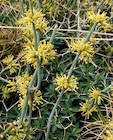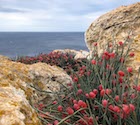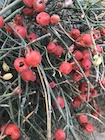Ephedra foeminea
Forssk. 1775
Common names
Leafless ephedra.
Taxonomic notes
Synonymy: see POWO, however also note that many collections attributed to E. major may in fact be E. nebrodensis, rather than E. foeminea.
Description
A climbing shrub up to 5 m tall, or prostrate. Twigs glabrous, gray-green, aging red-brown at first, later gray; slender, up to 2 mm in diameter. Uppermost bud elliptic; pith white. Leaves 2 per node, up to 2.5 mm long, basal sheath not swollen. Pollen cones 1 to several per node, up to 5 mm long; bracts 2 per node. Seed cones 1 to several per node, 8-9 mm long, narrow-cylindric before full maturity, stalk 2-10(-20) mm, generally curved; distal bracts 2 per node, round, fused for at least 2/3 their length, fleshy, red. Seeds (1-)2, 6-9 mm long at at least twice as long as wide, smooth. 2n=14 (Vidakovic 1991, Ickert-Bond 2012).
Distribution and Ecology
Albania, Bulgaria, Cyprus, Djibouti, Eritrea, Greece, Israel, Italy, Lebanon, Libya, Saudi Arabia, Sinai, Somalia, Syria, Turkey, Yemen, Yugoslavia (Plants of the World Online).
Remarkable Specimens
No data as of 2023.03.03.
Ethnobotany
Observations
See the observations on iNaturalist, accessed 2021.12.30.
Remarks
This is one of the insect-pollinated species of Ephedra, pollinated primarily by nocturnal flies and moths. The pollinators are attracted by nectar droplets exuded by both male and female flowers. Its pollination coincides with the full moon of July. Rydin and Bolinder (2015) explain, "This may be adaptive in two ways. Many nocturnal insects navigate using the moon. Further, the spectacular reflection of the full-moonlight in the pollination drops is the only apparent means of nocturnal attraction of insects in these plants."
Citations
Forsskål, P. 1775. Flora Aegyptiaco-arabica. Hauniae, ex officia Möller, p. 219. Available: Biodiversity Heritage Library, accessed 2021.12.26.
Ickert-Bond, S. M. 2012. Ephedra foeminea in Jepson Flora Project (eds.) Jepson eFlora, https://ucjeps.berkeley.edu/eflora/eflora_display.php?tid=85275, accessed 2021.12.26.
Rydin, C. and K. Bolinder. 2015. Moonlight pollination in the gymnosperm Ephedra (Gnetales). Biology Letters, doi.org/10.1098/rsbl.2014.0993.
See also
Species profile at Plants of the World Online, accessed 2021.12.30.
Al-saraireh, Y. M., Youssef, A. M., Alshammari, F. O., Al-Sarayreh, S. A., Al-Shuneigat, J. M., Alrawashdeh, H. M., and Mahgoub, S. S. (2021). Phytochemical characterization and anti-cancer properties of extract of Ephedra foeminea (Ephedraceae) aerial parts. Tropical Journal of Pharmaceutical Research 20(8):1675-1681.
Freitag, H. and M. Maier-Stolte. 1989. The Ephedra-species of P. Forsskål: Identity and typification. Taxon 38(4):545-556.
Khalil, M., Khalifeh, H., Saad, F., Serale, N., Salis, A., Damonte, G., Lupidi, G., Daher, A., and Vergani, L. 2020. Protective effects of extracts from Ephedra foeminea Forssk fruits against oxidative injury in human endothelial cells. Journal of Ethnopharmacology 260:112976. doi:10.1016/j.jep.2020.112976.




